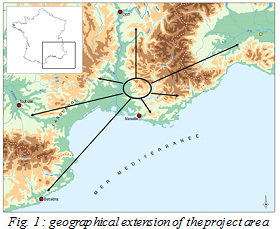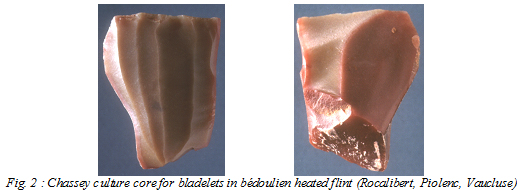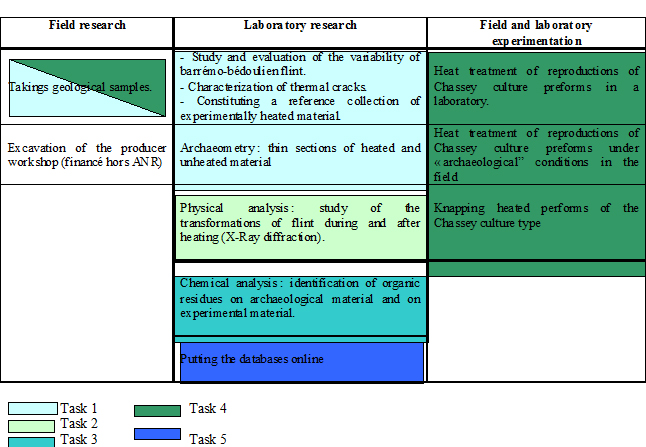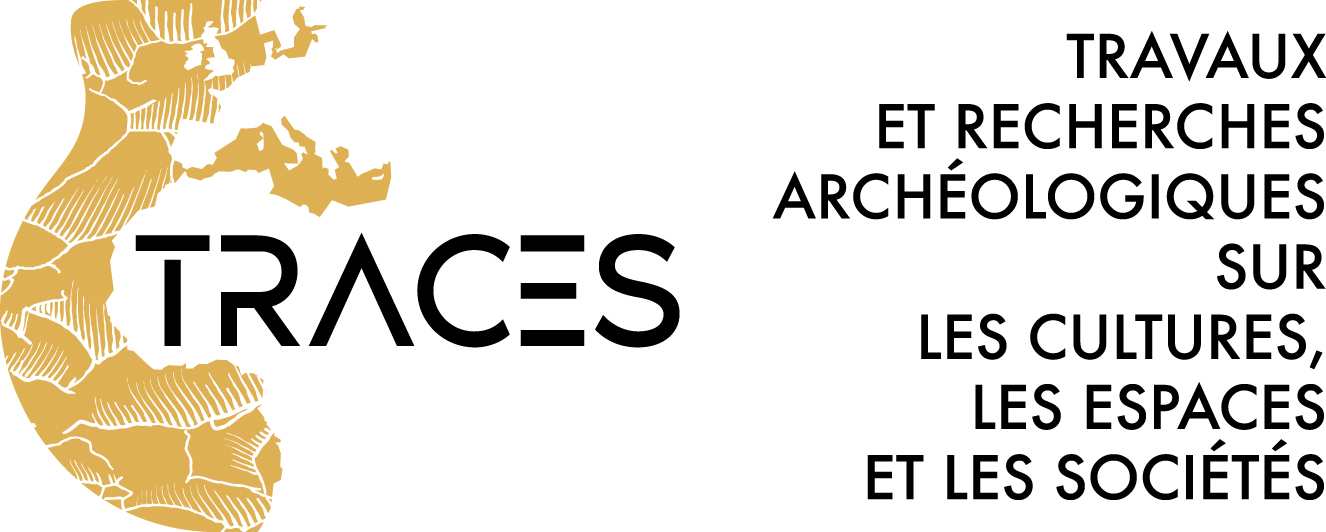-
Partager cette page
ANR ProMiTraSil
Processus et milieux du traitement thermique des silex barrémo-bédouliens au Chasséen (fin 5ème et 4ème mill. Cal BC, Méditerranée occidentale) / Processes and environments of heat treatment of barremo-bédoulian flint during the Chassey culture (end 5th and 4th mill. Cal BC ; western Mediterranean).
Partners : CEMES (Toulouse), CEPAM (Nice), GET (Toulouse)
Members : V. Léa (coord.), J. Vaquer, M.-P. Cousture, Ph. Sciau, Chr. Roucaud, D. Binder, M. Regert, A. Carre, J. Pelegrin, D. Beziat, Ph. De Parseval, J. Roque-Rosell, P. Schmidt, J. Milot.
1. General context
1.1. The cultural background
At the end of the fifth millennium (Cal. BC), an important change occurs in the evolution of the
 Neolithic societies from the north western Mediterranean. Profound socio-economic changes are reflected by two related phenomena: a more pronounced craft specialization and the development of long-distance trade. In archaeological terms, this is particularly visible in the southern Chassey culture stretching across the south of France. It is in this context that we see the exceptional dissemination of specialized lithic productions made in barremo-bedoulian flint from the Vaucluse: they are found on nearly 1000 Chassey culture consumer sites and in most cases constitute 99% of the tools. But the magnitude of these exchange networks is measured on a European scale since products from the Vaucluse are exported to Italy and Catalonia (fig. 1) as several of us were able to identify (D. Binder, V. Lea, J. Vaquer). Beyond the borders of the Chassey culture, they there enter into different cultural spheres such as Lagozza to the east and the Sepulcres de Fossa to the west where they have a special status among the funerary deposits (fig. 1).
Neolithic societies from the north western Mediterranean. Profound socio-economic changes are reflected by two related phenomena: a more pronounced craft specialization and the development of long-distance trade. In archaeological terms, this is particularly visible in the southern Chassey culture stretching across the south of France. It is in this context that we see the exceptional dissemination of specialized lithic productions made in barremo-bedoulian flint from the Vaucluse: they are found on nearly 1000 Chassey culture consumer sites and in most cases constitute 99% of the tools. But the magnitude of these exchange networks is measured on a European scale since products from the Vaucluse are exported to Italy and Catalonia (fig. 1) as several of us were able to identify (D. Binder, V. Lea, J. Vaquer). Beyond the borders of the Chassey culture, they there enter into different cultural spheres such as Lagozza to the east and the Sepulcres de Fossa to the west where they have a special status among the funerary deposits (fig. 1).How then to explain the extent of dissemination of Vaucluse productions? What prompted these Neolithic communities of the north-western Mediterranean to adopt the same tools, and for over 700 years? What in the manufacturing process justifies the high exchange value of these goods?
1.2. Exchanged specialized productions to be studied under the project
1.2. Exchanged specialized productions to be studied under the project
These questions will be addressed through the analysis of the particular production of the southern Chassey culture : it is characterized by heat treatment of the barremo-bedoulian flint so as to obtain thin bladelets by pressure. The intervention of heat treatment in the chaîne opératoire and the use of pressure technique permit to obtain a maximum number of blanks in a minimum of raw material. On the archaeological material, the heating of the flint is recognized by contrasts between the different surfaces: surfaces flaked of before heating remain dull while those flaked of after heating have a greasy luster which gives the impression of a "vitrification " of the flint. Often, the dull surfaces are reddened (fig. 2). These observations have led to infer that what was heated were blocks that had already undergone some form of shaping before pressure debitage.

The segmentation of the production of bladelets, in time and space, is linked to different expertise: the very delicate phases of formatting the pre-cores (performs or future cores for bladelets) take place on the producer sites in the Vaucluse and are performed by specialists, while on the consumer sites, the debitage of bladelets belongs to the domestic tasks that do not require the same skills. On one hand, on producing sites, the flint heat treatment is at the least a complex operation: creating an environment for heating, gradual increase of temperature, maintaining the temperature for a given time, gradual decline of temperature. On the other hand, on the consumer sites, the heat treatment facilitates the knapping of bladelets: detaching the bladelets would be easier due to lesser pressure needed (experiments by J. Pelegrin to continue).
The heating, essential and inevitable step in the chaîne opératoire for bladelets, is one of the fundamental keys for understanding this system in which producers and consumers are totally interdependent. The heating process thus illustrates the social division of labor between producers who know how to put in form and consumers who do not know. The issues of this project are important for the apprehension of these Neolithic societies. To take up the study of these barrémo-bédoulien flint industries and in particular the issue of heating, is to address the skills of the specialized craftsmen. These skills are not shared and only the knappers who control the sources of raw material in the Vaucluse master the manufacturing processes. What is exchanged and exported over such great distances and in such large quantities, is thus primarily a specific know-how.
2. Rationale highlighting the originality and novelty of the proposal
2.1 Project objectives
The differences observed macroscopically on the archaeological material between heated and unheated barrémo-bédoulien flints are such that prehistory archaeologists aware of the problem often consider that the heat treatment was for the prehistoric man a way to artificially create another raw material whose characters are quite close to obsidian. What are the heating processes and environments that make these transformations possible? As far as the context of our study is concerned, this issue is particularly important because, unlike what is known in other chrono-cultural contexts where there is heating for retouching tools (and not debitage), the heated modules are very large as is shown by recently found preforms on different producer workshops. However, a large volume of flint poses many problems for heating as it increases the risks of fracturing.
The objective of this project is to better understand the organization of Chassey culture societies by addressing the question of greater specialized craftsmanship, which is one of its most striking aspects. To do this we have chosen as the medium of study, what forms the most remarkable productions in terms of technical investment : the production of bladelets in heated barrémo-bédoulien flint. Our aim is to assess, for the first time, the not-shared know-how of these artisans. Within the chaîne opératoire, it is the heat treatment of flint, which raises at the moment most questions : what is environment is used for heating ? Is there an interaction between that environment and the heated flint ? What is the precise range of temperature that has to be reached? For how long? More precisely, what are the transformations of flint during and after heating : should we think about a new arrangement of the quartz crystals? What role is played by iron oxides? What evolution does the porosity of the bédoulien flint undergo within this temperature range? Furthermore, some varieties of bédoulien flint being much more often heated than others, is there a relationship between different bédoulien flint types and their reaction to heating ? Or, have they all the same aptitude for knapping after heating?
This project seeks a better understanding of the conditions necessary to make the heating a success. To this end, several approaches must be conducted in parallel:
- Archaeological approach: expert study in particular of failed heated flints found on the producer sites.
- Physical approach: what physical transformations have the barrémo-bédoulien flints undergone that can explain the observed changes? What happens at the atom scale?
- Chemical approach: analysis of residues found on the manufacturing waste from the preforms of St. Martin in order to obtain indications about the heating environment.
- Experimental approach: 1 / carry out heat treatments on reproductions of Chassey culture preforms in an oven in order to identify the range of temperatures in which barrémo-bédoulien flints undergo changes. 2 / assessing the effects of heat treatment on barrémo-bédoulien flints for the debitage of bladelets by pressure (fig. 3).

2.2 Expected Results
The expected results are several and divide differently depending on the different approaches considered :
- Archaeological Approach: The site of St. Martin where heat treatment was used, offers the possibility to find a heating installation for flint performs, a type of structure that remains at present quite unknown. The abundance of waste from the manufacturing of preforms will also permit to measure the successes and failures on this workshop.
- Physical-chemical approach: 1 / the physical approach will enable us to identify the transformations that take place inside the flint in response to the heating and thus to understand why the aptitude of flint for knapping is enhanced by heat treatment. 2 / The chemical approach will enable us to identify the type of residue found on heating wastes on the site of St. Martin and will offer several hypotheses about the nature of the heating environment used.
- Experimental Approach: 1 / The experimental heating in a muffle furnace will permit to better define the range of temperatures that affect the transformation of flint, taking into account the variability of barremo-bédoulien flints. Physical analysis will also be conducted during the course of the heating to understand what happens at different stages and levels of heat treatment. These tests should start in a neutral atmosphere, as a reference base of the possible effect of other conditioning (ochre sediment (s), fat oil). 2 / Experimental knapping will enable us to appreciate the improvement of the aptitude for knapping of the flint, so as to provide some insight into understanding the extent of the diffusion of these specialized Chassey culture productions.
3. Publications
* 2011 - J. Roque-Rosell, L. Torchy, C. Roucau, V. Lea, Ph. Colomban, M.Regert, D. Binder, J. Pelegrin, Ph. Sciau, 2011 : Influence of Heat Treatment on the Physical Transformations of Flint Used by Neolithic Societies in the Western Mediterranea, Materials Research Society proceedings, 1319. On line : http://journals.cambridge.org/action/displayIssue?jid=OPL&volumeId=1319&iid=8249735
* A paraître 2012 - sous presse - Vanessa Léa, Josep Roque-Rosell, Loïc Torchy, Didier Binder, Philippe Sciau, Jacques Pelegrin, Martine Regert, Marie-Pierre Cousture, Christian Roucau, sous presse : Craft specialization and exchanges during the southern Chassey culture : an integrated archaeological and material sciences approach. Revista Rubricatum.






